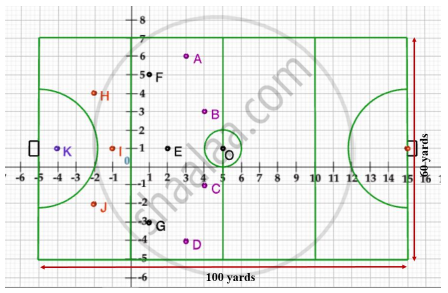Advertisements
Advertisements
प्रश्न
An equilateral triangle has two vertices at the points (3, 4) and (−2, 3), find the coordinates of the third vertex.
उत्तर
The distance d between two points `(x_1, y_1)` and `(x_2, y_2)` is given by the formula.
`d = sqrt((x_1 - y_1)^2 + (y_1 - y_2)^2 )`
In an equilateral triangle all the sides are of equal length.
Here we are given that A (3, 4) and B (−2, 3) are two vertices of an equilateral triangle. Let C(x, y) be the third vertex of the equilateral triangle.
First, let us find out the length of the side of the equilateral triangle.
`AB = sqrt((3 + 2)^2 + (4 - 3)^2)`
`= sqrt((5)^2 + (1)^2)`
`= sqrt(25 + 1)`
`AB = sqrt26`
Hence the side of the equilateral triangle measure `sqrt26` units.
Now, since it is an equilateral triangle, all the sides need to measure the same length.
Hence we have BC = AC
`BC = sqrt((-2-x)^2 + (3 - y)^2)`
`AC = sqrt((3 - x)^2 + (4 - y)^2)`
Equating both these equations we have,
`sqrt((-2-x)^2 + (3 - y)^2) = sqrt((3 - x)^2 + (4 - y)^2)`
Squaring on both sides we have,
`(-2 - x)^2 + (3 - y)^2 = (3 - x)^2 + (4 - y)^2`
`4 + x^2 + 4x + 9 + y^2 - 6y = 9 + x^2 - 6x + 16 + y^2 - 8y`
10x + 2y = 12
5x + y = 6
From the above equation we have, y = 6 − 5x
Substituting this and the value of the side of the triangle in the equation for one of the sides we have,
`BC = sqrt((-2 - x)^2 + (3 - y)^2)`
`sqrt26 =- sqrt((-2-x)^2 + (3 - 6 + 5x)^2)`
Squaring on both sides,
`26= (-2 - x^2 )^2 + (-3 + 5x)^2`
`26 = 4 + x^2 + 4x + 9 + 25x^2 - 30x`
`13 = 26x^2 - 26x`
`1 = 2x^2 - 2x`
Now we have a quadratic equation for ‘x’. Solving for the roots of this equation,
`2x^2 - 2 - 1 = 0`
`x = (2 +- sqrt(4 - 4(2)(-1)))/4`
`= (2 +- sqrt12)/4`
`x = (1 +- sqrt3)/2`
We know that y = 6 - 5x, Substituting the value of ‘x’ we have,
`y = 6 - 5((1 +- sqrt3)/2)`
`= (12 - 5 +- 5sqrt3)/2`
`y = (7 +- 5sqrt3)/2`
Hence the two possible values of the third vertex are `(1 + sqrt3)/2, (7 - 5sqrt3)/2 and (1 - sqrt3)/2, (7 + 5sqrt3)/2`
APPEARS IN
संबंधित प्रश्न
Prove that the points (–3, 0), (1, –3) and (4, 1) are the vertices of an isosceles right angled triangle. Find the area of this triangle
Find the distance of a point P(x, y) from the origin.
For what values of k are the points (8, 1), (3, –2k) and (k, –5) collinear ?
Determine whether the points are collinear.
L(–2, 3), M(1, –3), N(5, 4)
A point A is at a distance of `sqrt(10)` unit from the point (4, 3). Find the co-ordinates of point A, if its ordinate is twice its abscissa.
Show that the points (a, a), (-a, -a) and `(-asqrt(3), asqrt(3))` are the vertices of an equilateral triangle.
AOBC is a rectangle whose three vertices are A(0, 3), O(0, 0) and B(5, 0). The length of its diagonal is ______.
Case Study -2
A hockey field is the playing surface for the game of hockey. Historically, the game was played on natural turf (grass) but nowadays it is predominantly played on an artificial turf.
It is rectangular in shape - 100 yards by 60 yards. Goals consist of two upright posts placed equidistant from the centre of the backline, joined at the top by a horizontal crossbar. The inner edges of the posts must be 3.66 metres (4 yards) apart, and the lower edge of the crossbar must be 2.14 metres (7 feet) above the ground.
Each team plays with 11 players on the field during the game including the goalie. Positions you might play include -
- Forward: As shown by players A, B, C and D.
- Midfielders: As shown by players E, F and G.
- Fullbacks: As shown by players H, I and J.
- Goalie: As shown by player K.
Using the picture of a hockey field below, answer the questions that follow:

The point on y axis equidistant from B and C is ______.
Point P(0, 2) is the point of intersection of y-axis and perpendicular bisector of line segment joining the points A(–1, 1) and B(3, 3).
The distance of the point (5, 0) from the origin is ______.
